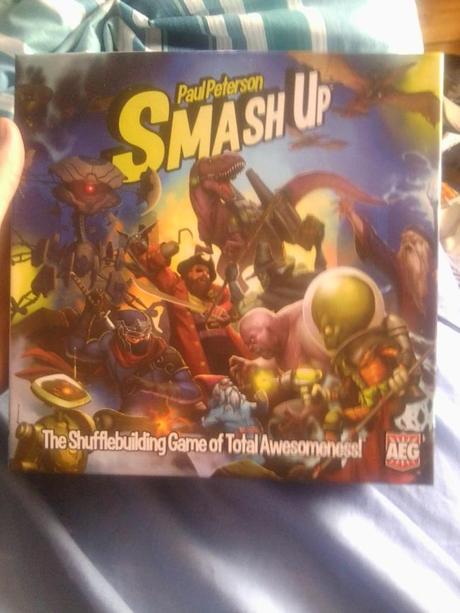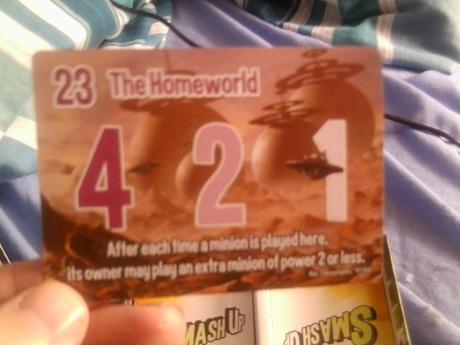
Smash Up is published by AEG and designed by Paul Peterson. It’s a shuffle-building game in which you choose two factions and try to win victory points by having more power on bases than your opponent(s). It plays 2-4 players. In this review I’m also going to be covering some of the stuff from the Awesome Level 9000 expansion. There have been two further expansions but I have not had a chance to play those. Here are the factions available in the base game:

I apologize for the poor picture quality. But from top right to left we have Pirates, Ninjas, Dinosaurs, Aliens, Wizards, Tricksters, Zombies and Robots. At the beginning of the game each player will pick two of these factions (although whenever I play I usually just randomly deal two out to each player) and shuffle them together, so you may get Ninja-Dinosaurs, Alien-Zombies, Robot-Pirates and so on. Each faction has different strengths, for example Dinosaurs are basically just brute force, while Wizards rely on chaining actions, which leads us to how to actually play the game.
There are two types of cards in every faction – Minions and Actions. On your turn you can always play one minion and one action. You can play them in whatever order you want and you can just play one of them if you want. However, most of the cards all have effects when you play them and some of these will allow you to play more cards. You’ll begin the game with five cards in your turn, and at the end of every turn you will draw two cards. You can have a maximum of ten cards in your hand after you draw these cards, so if you have more than ten you will have to discard cards. You’ll be playing minions (and some actions) on bases. A typical base looks like this:

The number in the top right is how much power it takes to ‘break’ a base. Each minion has a strength, so the power of all the minions on the base is added up and when it reaches or exceeds that number (in this case 23) the base has broken, and at the end of the current player’s turn it will be scored (this is an important distinction because after a base breaks there is still a chance for certain cards to alter the balance of minions on a base). Once the turn ends players will look at their minions and see who has the most power and then score accordingly. So the player with the most power will get four points, the next most-powerful player will get two and the third will get one. The bases also have some text on them, in this example players can play an extra minion of two or less whenever they play a minion here. Some effects on other bases only apply to the winner of the base. The number of bases in play is dependent on the number of players, and the first player to 15 points is the winner!
The expansion adds four new factions – Ghosts, Bear Cavalry, Plants and Steampunk, new bases, and victory point tokens.
Firstly I want to talk a bit about the expansion. The base game is really good and really fun, but it does come in a HUGE box. They obviously planned for future expansions. However, I can actually fit everything I have in the expansion box, which is far smaller and fits snugly into my cupboard. The expansion also includes base cards that replace the original base cards, because the text in the original game was rather small. The biggest addition though is the victory point tokens, because they make keeping score much easier and it means you don’t have to keep a pen and paper handy. From now on I will be talking about the base game and the expansion as a whole.
I LOVE Smash Up. The theme is really fun because you can just create so many cool combinations, and the sheer variety means that the games always feel fresh. Each faction has its own strategy so even though the theme seems silly the game itself actually does require some thought and planning as you try to find synergy between the two factions you have picked. There’s a little bit of number-crunching, especially when a base is close to breaking point and you’re trying to work out whether you can sneak past your opponent to steal it from him, or find some way to diminish his power. I think all the factions feel very different but none of them – apart from the Ghosts – are especially difficult to master, although you will have to adjust your style of play. My favorite faction are the aliens because one of their cards gives you a victory point every time you play it, and a lot of their other cards allow you to return minions to your hand, so you can accumulate a few extra points this way (and I just love aliens).
I love the artwork as well. It fits the tone of the game perfectly and all the iconography is really well-designed and allows you to differentiate between the factions easily. The rules are very simple and it’s easy to teach, although it does take a few plays to get used to what the cards do and remember what cards work best at which times. The game plays quickly though. I usually play this two player, and since I have twelve factions what I usually do is play the best of three games, choosing from the remaining factions as we go. These sessions usually last for around 45 minutes. On your first few plays it may take longer because you’re getting used to the cards, but once you play it more often you’ll be able to play pretty quickly.
The only negative I have about the game is that you can get bogged down in analysis. ‘If I do this then I can this much strength and play this extra minion, but if I play this one over here then I’ll have a better chance at winning that base,” etc, that kind of thing. This also introduces an element of bluffing to it as well, because once you’re familiar with the cards you’ll know what your opponent’s deck consists of, so you’ll be wondering whether he has a card that can stop you. It’s not a massive problem, but for those prone to analysis paralysis it could slow the game down for the other players, so I’d advise against them playing the Wizards. I also think the game is best with two players, because you really have that back and forth element. With more players a turn could go around the table and you won’t have a chance to affect things as much. In larger games, especially four player games, it can feel more like damage control sometimes rather than having the opportunity to implement a strategy.
Overall though I love this game. I think the theme is very silly but when you get to them it’s really clever and it rewards some planning. I like how the game has so much variation with the different combinations of factions and bases and how the basic rules of the game are so simple yet they lead to so many great combos. The other cool thing I meant to mention is that each expansion can be played as a standalone game as well, The base set has the most factions, but you could just get an expansion if you wanted to. I would recommend you get the base game and this expansion though, the text on the base cards weren’t a problem for me but the larger text is helpful. The big plus is the victory point tokens too, it’s only a little thing but it makes so much difference. I do love the new factions as well, except the Ghosts, but I’m trying to find a way to make them work properly. It’s easy to teach, quick to grasp and really fun to play.
